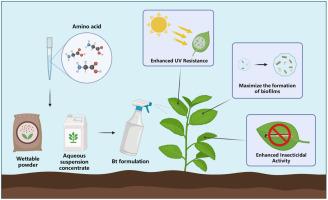l -氨基酸调节苏云金芽孢杆菌制剂中的生物膜形成、抗紫外线和杀虫活性:机制和优化
IF 4
1区 农林科学
Q2 BIOCHEMISTRY & MOLECULAR BIOLOGY
引用次数: 0
摘要
提高苏云金芽孢杆菌(Bt)生物农药的田间持久性是有效防治害虫的关键。本研究首次系统研究了所有20种l -氨基酸影响Bt生物膜形成、抗紫外线和杀虫活性的机制。结果表明,氨基酸具有界面调节剂的作用:非极性疏水类型(如l-亮氨酸)通过疏水粘附显著增加可湿性粉末中的生物膜生物量,而碱性类型(如l-精氨酸、l-赖氨酸)通过静电稳定增强水悬浮液浓缩物的稳定性。通过统计优化(Plackett-Burman设计和响应面法),确定了l-精氨酸、l-赖氨酸和l-亮氨酸的协同配方。该配方使商业Kernel 32,000 IU/mg可湿性粉末的生物膜产率提高了3.8倍,紫外线照射4小时后存活率提高了约50%。在生理毒理学水平上,该氨基酸组合对小菜蛾二龄幼虫的LC50降低了8.12倍。透射电镜显示,在处理过的中肠中,微绒毛完全脱落,线粒体嵴断裂,表明协同机制源于中肠上皮屏障的破坏。该研究首次提供了氨基酸介导的界面相互作用与中肠病理损伤之间的直接联系,为下一代低剂量、高稳定、耐药风险可控的Bt制剂提供了分子生理学证据。本文章由计算机程序翻译,如有差异,请以英文原文为准。

L-amino acids modulate biofilm formation, UV resistance, and insecticidal activity in Bacillus thuringiensis formulations: Mechanisms and optimization
Enhancing the field persistence of Bacillus thuringiensis (Bt) biopesticides is crucial for efficient pest management. This study presents the first systematic investigation into the mechanisms by which all 20 L-amino acids influence Bt biofilm formation, ultraviolet (UV) resistance, and insecticidal activity. The results demonstrate that amino acids functioned as interfacial modulators: non-polar hydrophobic types (e.g., L-leucine) significantly increased biofilm biomass in wettable powder through hydrophobic adhesion, whereas basic types (e.g., L-arginine, l-lysine) enhanced the stability of aqueous suspension concentrate via electrostatic stabilization. Through statistical optimization (Plackett-Burman design and response surface methodology), a synergistic formulation composed of L-arginine, l-lysine, and L-leucine was identified. This formulation increased the biofilm yield of the commercial Kernel 32,000 IU/mg wettable powder by 3.8-fold and improved survival rate by approximately 50 % after 4 h of UV irradiation. At the physio-toxicological level, this amino acid combination reduced the LC50 against second-instar Plutella xylostella larvae by 8.12-fold. Transmission electron microscopy revealed complete microvilli shedding and mitochondrial cristae breakage in the treated midgut, indicating that the synergistic mechanism stems from the disruption of the midgut epithelial barrier. This study provides the first direct link between amino-acid-mediated interfacial interactions and midgut pathological damage, offering molecular–physiological evidence for next-generation, low-dose, highly stable Bt formulation with manageable resistance risks.
求助全文
通过发布文献求助,成功后即可免费获取论文全文。
去求助
来源期刊
CiteScore
7.00
自引率
8.50%
发文量
238
审稿时长
4.2 months
期刊介绍:
Pesticide Biochemistry and Physiology publishes original scientific articles pertaining to the mode of action of plant protection agents such as insecticides, fungicides, herbicides, and similar compounds, including nonlethal pest control agents, biosynthesis of pheromones, hormones, and plant resistance agents. Manuscripts may include a biochemical, physiological, or molecular study for an understanding of comparative toxicology or selective toxicity of both target and nontarget organisms. Particular interest will be given to studies on the molecular biology of pest control, toxicology, and pesticide resistance.
Research Areas Emphasized Include the Biochemistry and Physiology of:
• Comparative toxicity
• Mode of action
• Pathophysiology
• Plant growth regulators
• Resistance
• Other effects of pesticides on both parasites and hosts.

 求助内容:
求助内容: 应助结果提醒方式:
应助结果提醒方式:


